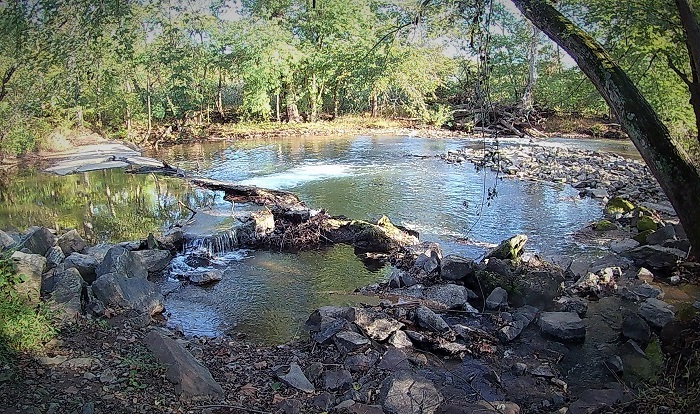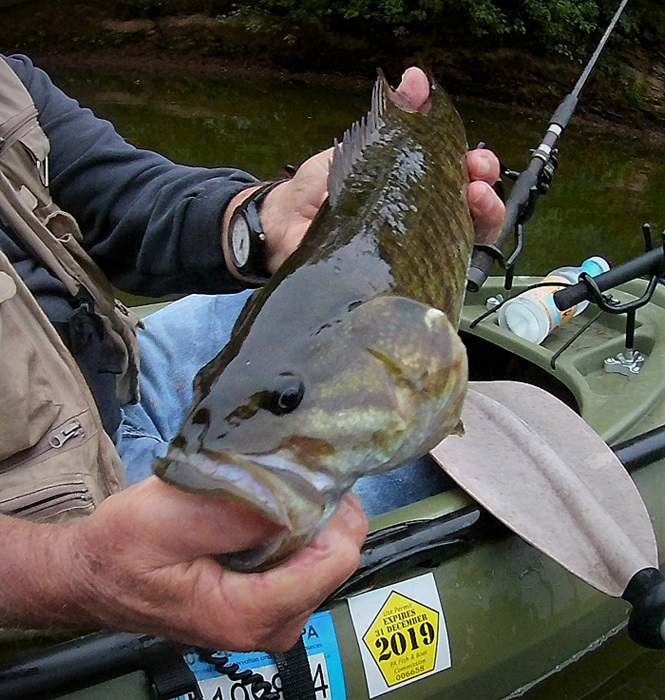
Maryland Small Stream Smorgasbord
The sights and sounds of fall are in the air and painting the landscape. As hunters scramble for vacation days and scouting trips, Free State anglers can expand their fishing season by concentrating on the many small, yet diverse, meadow streams and free-flowing creeks that snake through Central and Western regions of the state. A variety of species can be caught during the fall months and even into early winter as long as mild conditions prevail. Here’s a rundown of what is available in these sometimes-overlooked waters.
Smallmouth Bass
Whenever I fish a small stream, I am almost always targeting smallmouth bass. Their sheer strength and power make for great sport even with smaller versions of these fish that traditionally run 10 to 14 inches in central and Western Maryland flows. During October and November, smallmouths will strike in-line spinners, smaller plastic worms, diminutive crankbaits or 1/16th-ounce hair jigs. Deeper pools, long, slow stretches and spillway pools below small dams can see a variety of species stacked-up and feeding heavily as they prepare for winter and colder temperatures. Occasionally, a bass will exceed the 18-inch mark in some prime waters. However, any fish in the 14- to 16-inch range should be considered an adult fish and a candidate for release.

Along with hard-fighting creek smallmouths, two panfish species often save the day when the smallies get lockjaw. They are the red-breast sunfish and the rock bass (also known as “red-eyes”). Both of these willing gamesters seldom exceed eight or nine inches in length, but they are abundant and feed heavily during the fall. Many of the same lures that take smallmouths will catch them as well. Big fallfish, suckers, and even hold-over trout species often trickle down from stocked areas of designated trout water to add to the variety.

Tackle options can vary from one angler preference to another. However, we prefer light or ultra-light spinning tackle with six-pound test monofilament lines to cast the aforementioned lure options. Chest or hip waders will be needed as creek flows will be dropping from the mid-60 to the lower 50-degree mark as the waters cool. Additionally, larger systems such as the Monocacy, Conocacheague and the Patuxent can be fished with either a kayak or canoe.
Trout
Often bypassed for other species, trout, both stocked and naturalized or native, can offer a unique experience to the eleventh-hour angler. The Maryland Department of Natural Resources has an aggressive fall stocking program that sees rainbows, browns and the popular golden, or palomino trout implanted in many central and western Maryland waters for anglers to enjoy. Some stocked streams have special regulations in regard to catch and release, angler harvest or angling methods. Please consult the Maryland Department of Natural Resources’ trout fishing page for a complete list of regulations for trout waters.

Tackle options for stocked trout vary from one angler to the next, but we prefer to catch them on ultra-light spinning gear and four-pound test monofilament. Small spoons at 1/16th-ounce and in-line spinners at #0 to #2 blades can coax aggressive stocked fish as they strike hard and fight with fury. Try tiny hair jigs in 1/64th-ounce weights and in dark patterns to generically represent a multitude of food items in the trout’s diet. Also, where permitted, commercially prepared trout dough and pastes are effective and often lead to many limits of trout.

Another option for autumn’s trout fishing is the quest for native brook trout, which do exist in some streams in the Catoctin Mountain/Frederick County area, as well as many tributaries to the Savage River system in Garrett County. Heralded as the only true and native trout species in Maryland waters, native brook trout fishing often requires long hikes, diligent mapwork and cautious, quiet approaches with small wet and dry flies and short but accurate casts. Most “natives” are but six to eight inches long but are beautifully marked as they are in their spawning hues as males turn crimson red with stunning white fin-edging and orange spots. Some anglers simply enjoy the thrill of finding them and observing them in their native habitat, choosing not to even fish for them.
Carp and Catfish
Most Central and Western Maryland streams have varying populations of carp and some contain channel catfish. As the heavyweights of the creeks, these fish obviously require bigger and stronger tackle than the smaller species. We fish for carp with prepared dough baits and corn fished on 15- to 20-pound test braided lines or monofilament. Often, the weight of a golf ball-sized bait is all that is required as these fish prefer long, slow-moving deep pools to navigate the bottom and seek out crayfish, scuds and other morsels. Canned sweet corn is a budget bait for these fish and often as good as it gets for bait options for the overgrown goldfish. Thread the corn kernels on a #2 or #4 baitholder hook and add a few split-shots16-inches up the line for a little casting weight but with little resistance to the carp’s spooky feeding nature.
 Courtesy of Patrick Kerwin
Courtesy of Patrick KerwinChannel catfish, on the other hand, prefer live or fresh cut baits, in particular, native sunfish species or cut bluegills from a local pond. They will slam lures and can even be caught on the fly rod (as can the carp). The bigger cats are active during low-light periods but can be caught mid-day as well. Use medium spinning tackle with 15- to 20-pound test braided lines or monofilament with #2 or #1 circle hooks for clean, safe hookups with these bruisers. Similar to the bottom-feeding carp, cats like long, deep pools but will often feed higher in the water column when actively chasing baitfish or minnows.
Practically every tributary to the upper Potomac River has channel catfish and carp in fishable numbers, and the lower section of the Monocacy River has seen an upgrade in channel catfish in recent years. You may encounter an unwanted guest, the invasive flathead catfish. Some anglers, however, are singing praises for the new fish in town, and purposely seek flatheads for both food and sport.
So, whatever your sport, and whatever you choose to fish for this fall and early winter, make a plan to hit a creek for smallmouth bass, willing trout, or giant carp and catfish. Variety awaits!
Where to Start
Here are a few starting points to get in on the fish this fall…
Trout:
- Allegheny County: Evitts Creek and Wills Creek
- Howard County: Little Patuxent and Middle Patuxent Creeks
- Baltimore County: Patapsco River, Daniels and Avalon Areas
- Carroll County: Morgan Run
- Frederick County: Big Hunting Creek, Little Hunting Creek, Owens Creek, and Frederick City Watershed
- Washington County: Antietam Creek
- Garrett County: Savage River and adjoining tributaries
Smallmouth Bass:
- Frederick and Carroll Counties: Monocacy River, RT 77 bridge downstream to Dickerson which is the Monocacy Scenic River Trail, many access points. All Tributaries to the Monocacy. Be sure you have permission before accessing private land.
- Potomac River and Central Maryland tributaries.
- Allegheny County: lower portions of Fifteen Mile Creek, Town Creek, and Wills Creek
Check out the 2019 Maryland Fishing Guide for special regulations, closures and special management areas. Whether you’re planning a few hours on the water or a longer family getaway, check out the Plan Your Trip section of our website to find lodging options, fishing charters and guides, and outdoor retailers to get the most out of fishing in Maryland.
Fall is beautiful in Maryland, so consider turning your fishing trip into a road trip. The Scenic Byways are a perfect way to explore.
This article was written by Jim Gronaw
Images courtesy of the author and Patrick Kerwin via the Maryland Department of Natural Resources Flick account